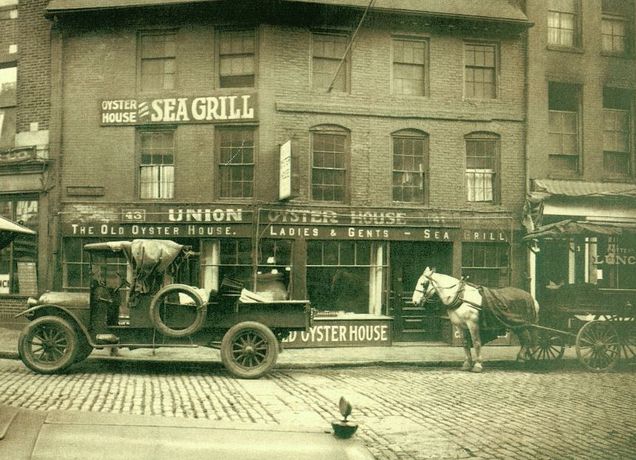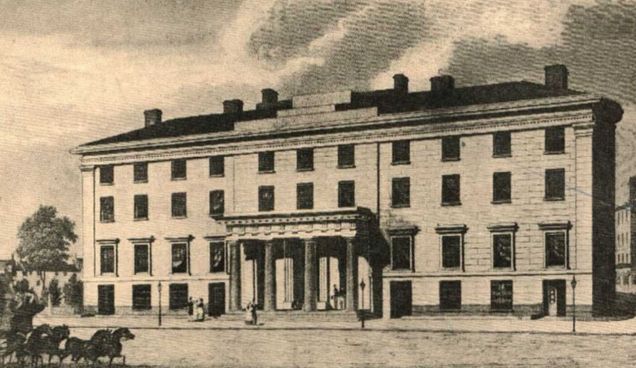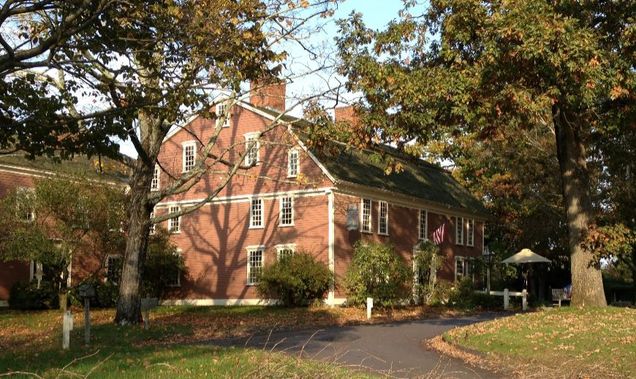The Cradle of American Hospitality

Used by permission from Union Oyster House
By Bradford Hudson
The Cradle of American Liberty is a term that has been applied to the City of Boston in general, and Faneuil Hall in particular, since the Revolutionary era. It could be argued that Boston also deserves credit as the Cradle of American Hospitality. An astonishing array of firsts and near firsts in the history of the modern hospitality sector have occurred in and around Boston, and some of the oldest surviving hospitality businesses in the United States may be found in the area today.
Boston was not the first European settlement in America, but it assumed a leading position in terms of population and trade during the colonial era. Established in 1630, it developed into the largest city and the busiest seaport during the century from 1650 to 1750. This was a formative period in the evolution of American enterprise and culture, and the emergence of services in the hospitality sector. Although the city was eclipsed by Philadelphia and New York by the end of the eighteenth century, Boston remained among the five largest cities until 1860 and among the top ten until 1950. It also retained its role as the epicenter of business and travel for most of the New England region. As such, Boston continued to provide a fertile environment for the hotel and restaurant industries through the first half of the twentieth century.
Restaurants
The predominant form of hospitality business in America prior to 1800 was the tavern. Recognized by a variety of names – including public houses, inns, and ordinaries – taverns typically offered food and drink for travelers and local residents. They were small facilities by the standards of today, situated in buildings that were often converted from prior use as family homes. The first tavern in Boston was licensed to Samuel Cole in 1633. This was followed shortly thereafter by establishments founded by William Baulston (1637), Richard Fairbanks (1639), and William Hudson (1640). A century later, there were more than 150 taverns operating in the city.
Another early form of hospitality business was the coffee house. Established as venues of public entertainment in manner similar to taverns (and distinct from retail stores) such entities offered coffee, chocolate, and prepared foods for consumption on the premises. The first license to operate a coffee house in Boston was granted to Dorothy Jones in 1670. Other early coffee entrepreneurs included Jane Barnard (1670), Abell Porter (1671), and Abigail Johnson (1672).
Prepared foods could also be purchased at ‘cook shops’ throughout colonial Boston. The exact meaning of this phrase varied to include dining rooms connected to taverns, independent venues similar to modern restaurants, and retail stores offering prepared foods for consumption elsewhere.
The common element was preparation of meals and meal components by professional cooks on behalf of consumers. The first cook shop to be licensed separately from a tavern was founded by John Lewis in 1663. His competitors soon included Thomas Hawkins and William Kent (both 1665). Within a decade, there were more than a dozen independent cook shops in Boston.
The term ‘restaurant’ did not enter the vernacular until the late eighteenth century. It derives from the French word restorant (something that restores) and its particular usage to describe bouillons(meat broths) intended to restore health. These were first sold in Paris by specialized retailers, who eventually added seating in manner similar to coffee houses.
The first establishment in Boston to use this appellation, and possibly the first French restaurant in the United States, was the Restorator. This was founded in 1793 by Jean Baptiste Gilbert Palyplat, who traded under the name Julien. He had previously been the household steward for the French consul in Boston.

Source: Crawford, Old Boston Days & Ways (1909)
As the modern form of restaurant began to emerge during the first half of the nineteenth century, Boston was at the forefront of this movement.
Among the first themed restaurants were oyster cellars or houses, which remained immensely popular for more than a century. There were 69 oyster houses listed in the Boston Directory by 1848.
The Atwood family was operating oyster shops in Boston before 1820 and subsequently opened Atwood’s Oyster House in 1826, on Union Street adjacent to Faneuil Hall. This later became Atwood & Bacon’s Oyster House and eventually the Union Oyster House. Famous guests over the years included Daniel Webster, who served as secretary of state for three presidents, and John F. Kennedy.

The following year, partners John Durgin and Eldrige Park opened the Durgin-Park restaurant, within the newly constructed Quincy Market complex adjacent to Faneuil Hall. By the middle of the century, the Boston Directory listed 105 restaurants in addition to public houses and oyster bars.
Around this time, an establishment was opened on Winter Place, which evolved into the Restaurant Parisien by 1865. A decade later, it was owned by Luis Ober. By the end of the century, it had been merged with the adjacent wine rooms of Frank Locke. Subsequently known as the Locke-Ober Restaurant, it became the preferred venue for generations of proper Bostonians.
The early restaurants of Boston were not limited to American, English, or French cuisine. A German restaurant was founded by Jacob Wirth in 1868, which relocated across Stuart Street a decade later. During the latter half of the nineteenth century, adventurous Bostonians were dining at a variety of ethnic restaurants including Jewish delicatessens and Italian cafes in the North End, and Chinese restaurants on Harrison Avenue.
As the phenomenon of chain restaurants and fast food began to emerge, entrepreneurs in the Boston area continued to develop new types of foodservice offerings. Charles Eaton founded Thompson’s Spa in 1882, which subsequently evolved into a multi-unit enterprise that pioneered service and production methods inspired by industrial models.
Several decades later in 1925, Howard Johnson acquired a drugstore and soda fountain in nearby Quincy. His attempts to improve the business through product development resulted in a superior ice cream recipe, involving a higher percentage of butterfat than competitors. He broadened his concept to include a limited food menu, and subsequently built an empire of mid-scale restaurants.
Howard Johnson’s grew to more than 1,000 units and dominated the chain restaurant industry during the mid-twentieth century
Hotels
Taverns represented not only the first foodservice establishments in colonial America, but also the first lodging businesses. Many offered overnight accommodations for travelers upstairs, including some of the public houses in Boston and almost every tavern elsewhere in New England.
About twenty miles west of Boston, along the Boston Post Road in Sudbury, David Howe began to offer hospitality services from his home in 1716. The celebrated poet Henry Wadsworth Longfellow visited in 1862, and subsequently used the Howe Tavern as the setting for his collection Tales of a Wayside Inn. The tavern quickly became known informally as ‘Longfellow’s Wayside Inn,’ which was adopted as its official name in 1897.Boston newspapers during the colonial era typically used the word ‘hotel’ to describe the private accommodations of nobility in Europe, rather than as a reference to a transient lodging facility. This changed during the third quarter of the eighteenth century, when the notion of a public hotel began to emerge, albeit still referring to accommodations located in major cities in Europe. Usage in the current sense appeared after 1793, when a national lottery was organized by the Federal government to finance construction of a commercial hotel in the District of Columbia, with the prize being ownership of the hotel itself.
Among the earliest hotels in America, and the first property to emerge with characteristics similar to modern hotels, was the Boston Exchange Coffee House and Hotel, which opened in 1809. The seven-story building had more than 200 rooms and an atrium covered in glass panels. Facilities included a ballroom, restaurant, coffee house, reading rooms, retail stores, offices, and a financial exchange floor.

Source: A Collection of Interesting and Historic Prints
(1909)
The name derives from the longstanding practice of merchants and financiers conducting business in coffee houses. The hotel was the largest building of any type in the United States at the time, with construction costs exceeding a half-million dollars.
Arguably the most famous American hotel of the nineteenth century was the Tremont House in Boston, which opened in 1829. The building had 170 rooms, a large restaurant, a bar, reading rooms, lounges, offices, and retail shops. It may also be considered the first luxury hotel in the modern sense, due to high standards for service and an array of innovative features. These included an arrival lobby, private rooms with individually keyed locks, gas lighting, indoor plumbing including water closets and baths, and a bell communication system in each room (requiring creation of the first ‘bellmen’ to respond).
Other notable early hotels in Boston included the American House (1835), the United States Hotel (1840), Young’s Hotel (1845), the Revere House (1847), and the Parker House (1855). The latter became a favorite location for literati such as Charles
Dickens and the Saturday Club dining society, which included Ralph Waldo Emerson and Henry Wadsworth Longfellow. Boston had 70 hotels by 1883 and more than a hundred at the beginning of the twentieth century.
The tradition of leadership in hotels continued in 1927, when the Ritz-Carlton opened in the Back Bay neighborhood. Although this was not the first hotel to operate under the brand name, it did provide a key link between the legacy of César Ritz and the current Ritz-Carlton chain operated by Marriott. After it was acquired in 1983, the Boston hotel provided not only the legal basis for expansion of the trademark, but also the conceptual basis for the interior design and service style of all Ritz-Carlton hotels built during the following decade.
Boston also participated significantly in the rise of chain and conglomerate hotel companies. In 1933, local financiers Ernest Henderson and Robert Moore acquired a hotel in nearby Cambridge. They subsequently purchased additional hotels in Boston and throughout the eastern United States, to assemble a collection of hotels under the Sheraton brand name. A decade later, Sheraton was the first hotel company to be traded publicly on the New York Stock Exchange.
Education
Boston may rightly claim the distinction of being the home of higher education in culinary arts and hospitality management. Although there were earlier precedents in Philadelphia, culinary schools in Boston were among the first to appear in the United States. The Boston Cooking School was established by the Woman’s Educational Association in 1879. This became widely known two decades later, when Little Brown & Company published the best-selling Boston Cooking School Cook Book, written by Fannie Farmer. The school was absorbed by Simmons College in 1903, thereby becoming the first collegiate program in culinary arts.
The first program in hotel management at the collegiate level was established in 1922 at Cornell University in upstate New York, but the story of its founding actually begins in Boston. Howard Meek managed the Ocean House Hotel in Maine during the summer season and served as an instructor in mathematics at Yale during the academic year. In 1921, he was asked to teach a new course in hotel management at his alma mater
Boston University, for which he commuted from New Haven. The following year, he was hired as the first instructor of hotel management at Cornell University, and he would subsequently become the founding dean when the program was elevated to school status.
Thus the first collegiate instruction in hospitality management occurred at Boston University, which continued to offer such courses recurrently until a formal program was established in 1981.
The Legacy Continues
Today, numerous historic hospitality businesses continue to operate in the Boston area. The Union Oyster House is recognized as a National Historic Landmark and is the oldest restaurant in continuous operation in the United States, while the Wayside Inn is listed on the National Register f Historic Places and is one of the oldest lodging properties operating in the United States. Other celebrated venues include the Parker House hotel, and the Durgin-Park and Jacob Wirth restaurants.
Boston remains the most populous city in New England, and it anchors a metropolitan statistical area that is currently ranked among the ten largest in the United States. As such, it continues to support a vibrant and innovative hospitality sector, including some of the finest hotels and restaurants in the United States. Boston has several properties that received Five Star ratings this year from the prestigious Forbes Travel Guide, including three hotels (among 57 nationwide) and one restaurant (among 25 nationwide).
Historians a century hence will have a better perspective on the importance of developments of the past few decades, but the region seems to have remained at the forefront of economic and social trends related to travel and food. Foremost among these are computer technology and environmental sustainability.

Source: A Collection of Interesting and Historic Prints
(1909)
Boston was the epicenter of the computer industry during its early years, due to a partnership between the academic community and entrepreneurs along the Route 128 corridor. Although subsequently eclipsed by Silicon Valley, the information technology sector continues to be an important part of the local economy. Boston has been ranked repeatedly among the best American cities for technology jobs during the past decade, and several important technology firms related to hospitality have local origins. These include TripAdvisor, which was recently listed among the five most popular travel websites by the Nielsen rating organization.

Source: Bradford Hudson, used by permission
Boston was ranked recently among the top five American cities for green jobs by Forbes. The Lenox Hotel in Boston has been recognized as a pioneer in the green hotel movement, while the Element Hotel in nearby Lexington was the test location for the first major hotel brand to require LEED certification for every property. On the food side, Boston was recently ranked among the top ten cities for fresh and local food in research conducted for the S.C. Johnson Company, and several New England states have been highly ranked in studies and surveys related to the local and slow food movements.
Boston entrepreneurs have been pioneers in the hospitality sector for nearly four centuries. If past is indeed prologue, the city will continue to influence the hotel and restaurant industries in years ahead.
ABOUT THE RESEARCH
Sources for this article included an official anthology (1881) of records from the City of Boston during the seventeenth century (1660-1701), numerous publications from the eighteenth and nineteenth centuries including newspapers and guide books, various editions of the Boston Directory (1820-1868), historical data from the United States Census Bureau, historical profiles provided by some of the firms still operating, and a multitude of secondary sources.
